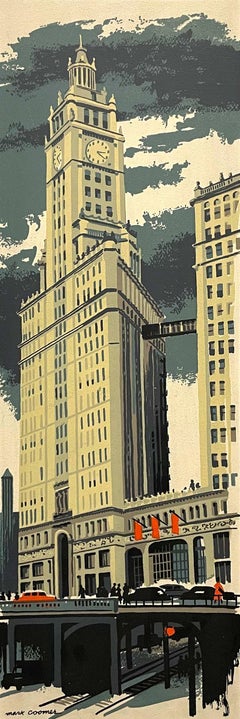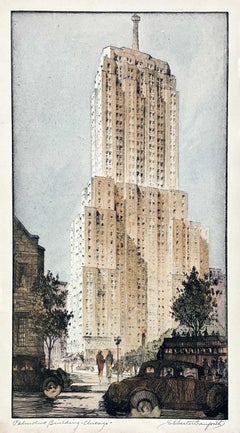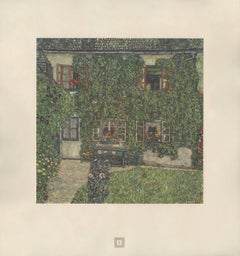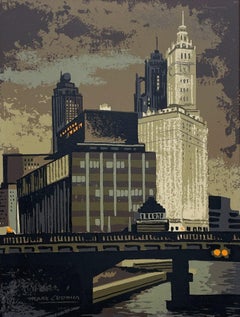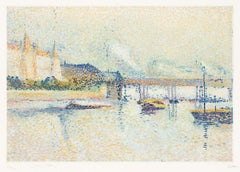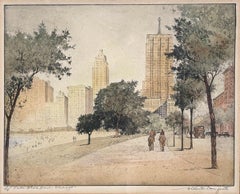Illinois - Landscape Prints
to
1
38
33
12
4
Overall Width
to
Overall Height
to
23
14
8
8
3
2
1
1
18
5
5
4
3
28
6
48
5
18
4
11
1
8
2
1
1
4
66
16
4
39
25
12
12
10
8
7
6
6
5
5
4
4
4
4
4
4
3
3
2
38
33
16
7
5
26
11,097
4,616
Item Ships From: Illinois
A Fabulous 1950s Serigraph of Chicago's Wrigley Building by Mark Coomer
Located in Chicago, IL
You really need to bring home this wonderful serigraph for your collection! A fabulous Mid-Century, ca. 1959 serigraph of Chicago's Wrigley Building in its original (and kitchy!) fr...
Category
1950s American Modern Illinois - Landscape Prints
Materials
Paper, Screen
A 1930s Etching & Aquatint of Palmolive Building Chicago by S. Chester Danforth
Located in Chicago, IL
A 1930s, Art Deco etching & aquatint of the Palmolive Building in Chicago by notable print maker S. Chester Danforth. Image size: 14 1/4" x 8". Archivally matted to 20" x 14".
S....
Category
1930s Art Deco Illinois - Landscape Prints
Materials
Paper, Etching, Aquatint
Max Eisler Eine Nachlese folio “House in a Garden” collotype print
By (after) Gustav Klimt
Located in Chicago, IL
After Gustav Klimt, Max Eisler #9, Haus Im Garten; aka Forester’s House in Weissenbach II; multi-color collotype after 1914 painting in oil on canvas.
GUSTAV KLIMT EINE NACHLESE (GU...
Category
1930s Vienna Secession Illinois - Landscape Prints
Materials
Paper
Fantastic Mid-Century Mark Coomer Serigraph of Chicago River & Wrigley Building
Located in Chicago, IL
You need this fantastic Mid-Century serigraph of Chicago's iconic Wrigley Building & Tribune Tower by artist Mark Coomer, in its original off-white panel f...
Category
1950s American Modern Illinois - Landscape Prints
Materials
Masonite, Screen
Londres (London)
By Maximilien Luce
Located in New York, NY
Pencil signed by both Luce and Jacques Villon (Villon etched the image) and numbered 120/200 in pencil, lower margin. Published by Galerie Bernheim-Jeune, Paris.
Catalogue Raisonne:...
Category
1920s Pointillist Illinois - Landscape Prints
Materials
Etching, Aquatint, Color
$3,900
1920s Deco etching & aquatint Lake Shore Drive, Chicago by S. Chester Danforth
Located in Chicago, IL
A 1920s, Art Deco etching & aquatint of Lake Shore Drive -- Chicago, by notable print maker S. Chester Danforth. Image size: 8 1/4" x 10 1/4". Archivally matted to 14" x 16".
Mandel Brothers...
Category
1920s Art Deco Illinois - Landscape Prints
Materials
Paper, Etching, Aquatint
H.O. Miethke Das Werk folio "Sunflower" collotype print
By Gustav Klimt & K.K. Hof-und Staatsdruckerei
Located in Chicago, IL
Sunflower, no. 10 from the third installment of Das Werk Gustav Klimts
Created during his residency in Litzlberg on Attersee, where Klimt and the Floge family summered from 1900-1907, Klimt explores nature’s transcendental qualities. His single sunflower is human-like, it’s golden halo is like a ring of sun-kissed hair surrounding a bald pate. It’s known that at the same time Klimt was creating this image, he was also at work on a photo essay about the Floge sisters’ clothing from their fashion salon. Their fashion house was best known for its “reform dresses” which featured loose-fitting long robes which billowed at the arms and torso. Viewed with this in mind, it is not a hard leap to imagine the lone sunflower as a self-portrait from reverse. Klimt’s balding head crowned in a golden corona forms the apex of a pyramidal flowing gown of foliage and flowers. By orienting the anthropomorphic flower at the garden’s central foreground and adorning it with repetitive motifs of round flowers of varying sizes, Klimt’s sunflower...
Category
Early 1900s Vienna Secession Illinois - Landscape Prints
Materials
Paper
A Fabulous ca. 1950s Mid-Century Serigraph of the Chicago Skyline by Mark Coomer
Located in Chicago, IL
You really need to bring home this wonderful & handsome serigraph for your collection! A fabulous ca. 1959, Mid-Century serigraph of the Chicago Skyline by artist Mark Coomer...
Category
1950s American Modern Illinois - Landscape Prints
Materials
Paper, Screen
Skyline (San Francisco)
By Bernard Buffet
Located in New York, NY
Signed and numbered 19/150 in pencil, lower margin. Printed by Mourlot, Paris. Published by Editions San Francisco Grafic, San Francisco. From Album San Francisco.
Catalogue raison...
Category
1990s Modern Illinois - Landscape Prints
Materials
Lithograph, Color
Charles Louis Balzac ca. 1809-1829 Engraving Koum Omboû (Ombos)
Located in Chicago, IL
An engraving on paper by Charles Louis Balzac, "DESCRIPTION DE L'EGYPTE. Koum Omboû (Ombos) Vue du Grand Temple". (ANTIQUITES, volume I, planche 40). Artwork size: 21" x 28". Arch...
Category
Early 19th Century French School Illinois - Landscape Prints
Materials
Paper, Engraving
Fantastic Mid-Century Serigraph of the Executive House Chicago by Mark Coomer
Located in Chicago, IL
You definitely need this fantastic Mid-Century serigraph of Chicago's Executive House hotel and the Chicago River by artist Mark Coomer, in its original of...
Category
1950s American Modern Illinois - Landscape Prints
Materials
Masonite, Screen
Fine Etching of Municipal (Midway) Airport Chicago by Kent Hagerman
By Kent Hagerman
Located in Chicago, IL
A fine & captivating etching of Municipal (Midway) Airport Chicago by artist Kent Hagerman. Artwork size: 7" x 10". Archivally matted to 12" x 16".
Kent Hagerman, also known as ...
Category
1950s American Modern Illinois - Landscape Prints
Materials
Paper, Etching
Max Eisler Eine Nachlese folio "Houses in Unterach on Lake Attersee" collotype
By (after) Gustav Klimt
Located in Chicago, IL
After Gustav Klimt, Max Eisler Plate #29, Am Attersee; brown-toned monochrome collotype after the 1915-16 painting in oil on canvas.
GUSTAV KLIMT EINE NACHLESE (GUSTAV KLIMT AN AFTERMATH), a portfolio of 30 collotypes prints, 15 are multi-color and 15 are monochrome, on chine colle paper laid down on heavy cream-wove paper with deckled edges; Max Eisler, Editor-Publisher; Osterreichischer Staatsdruckerei (Austrian State Printing Office), Printer; in a limited edition of 500 numbered examples of which: 200 were printed in German, 150 were printed in French and 150 were printed in English; Vienna, 1931.
2018 marks the 100th anniversary of Gustav Klimt’s death. It is a fitting time to reflect upon the enduring legacy and deep impact of his art. Recognizing this need for posterity with uncanny foresight, the publication of Gustav Klimt: An Aftermath (Eine Nachlese) provides a rare collection of work after Klimt which has proven to be an indispensable tool for Klimt scholarship as well as a source for pure visual delight.
Approximately 25 percent of the original works featured in the Aftermath portfolio have since been lost. Of those 30, six were destroyed by fire on 8 May 1945. On that fateful final day of WWII, the retreating Feldherrnhalle, a tank division of the German Army, set fire to the Schloss Immendorf which was a 16th century castle in Lower Austria used between 1942-1945 to store objects of art. All three of Klimt’s Faculty Paintings: Philosophy, Medicine and Jurisprudence (1900-1907), originally created for the University of Vienna, were on premises at that time. Also among the inventory of Klimt paintings in storage there was art which had been confiscated by the Nazis. One of the most significant confiscated collections was the Lederer collection which featured many works by Gustav Klimt such as Girlfriends II and Garden Path with Chickens. In many instances, Aftermath is our only link to these lost treasures.
Max Eisler (1881-1937), the publisher of the 1931 Aftermath portfolio, was an art historian at Vienna University specializing in modern and contemporary arts and crafts whose 1920 book on Klimt was the first Klimt monograph. He saw An Aftermath as filling-in important gaps left by the earlier print portfolios which had only featured Klimt up to 1913 and which had glossed over major art projects such as the Tree of Life frieze for the Palais Stoclet. And whereas only 10 of the 50 prints from the earlier portfolios published by H.O. Miethke were made in intricate multi-color images, Eisler augmented the earlier format by featuring half of the 30 images in stunning multi-colored collotypes. Understanding the fragile nature of the collotype printing process also reinforces this project’s distinctive and exceptional characteristics. Fragile collotype plates can not be reused. As such, this necessitates the completion of a run on the first go and also dictates a limited production number. Printed by hand, the collotypes required deft handling by the printer, Osterreichische Staatsdruckerei. A complicated and lengthy process involving gelatin colloids mixed with dichromates, the creation of 16 color separation thin glass filters to achieve the light-sensitive internegative images which could faithfully capture all of the painting’s tonal gradations and colors, exposure to actinic light, and delicate chine collie papers which allowed for greater color saturation, the printer’s collaborative role in capturing and transmitting Klimt’s nuanced paint strokes is nothing short of remarkable.
The Österreichische Staatsdruckerei (Austrian State Printing Office), was the successor to the KK Hof -und Staatsdruckerei which was founded by Emperor Franz I in 1804 and whose collotype printing innovations of Klimt’s art...
Category
1930s Vienna Secession Illinois - Landscape Prints
Materials
Archival Paper
A Handsome Woodcut on Paper of the Univ. of Chicago Chapel by Siegfried Weng
Located in Chicago, IL
A handsome woodcut on paper of the University of Chicago Chapel by artist Siegfried Weng. A perfect gift for your U of C grad! Arwork size:
9 3/4" x 7 1/2". Archivally matted to...
Category
1920s American Modern Illinois - Landscape Prints
Materials
Paper, Woodcut
Resting The Horses
By Olaf Wieghorst
Located in New York, NY
Etching, 1937. Signed by the artist and dated in pencil lower right margin.
A scarce etching by this important American western artist.
Category
1930s American Realist Illinois - Landscape Prints
Materials
Etching
French Art Exhibition Poster by Raoul Dufy, Modernist Lithograph, 1959
By Raoul Dufy
Located in Chicago, IL
"Exposition d'Art Français" features a busy, dreamy depiction of the French countryside in a very loose style. Created by Raoul Dufy as the poster for an exhibition held in Kaunas, L...
Category
1930s Illinois - Landscape Prints
Materials
Lithograph
A ca. 1940 Etching Titled "Tip of Manhattan" by Artist Nat Lowell
By Nat Lowell
Located in Chicago, IL
A ca. 1940 etching of a view of the Manhattan skyline by artist Nat Lowell. Signed and titled in pencil, ca. 1940. Artworks size: 4 1/4" x 5 1/4". Arc...
Category
1940s American Modern Illinois - Landscape Prints
Materials
Etching, Paper
Max Eisler Eine Nachlese folio "Gastein" collotype
By (after) Gustav Klimt
Located in Chicago, IL
After Gustav Klimt, Max Eisler Plate #21, Gastein; grey-green monochrome collotype after the 1917 painting in oil on canvas. Original destroyed by fire May 1945.
GUSTAV KLIMT EINE NACHLESE (GUSTAV KLIMT AN AFTERMATH), a portfolio of 30 collotypes prints, 15 are multi-color and 15 are monochrome, on chine colle paper laid down on heavy cream-wove paper with deckled edges; Max Eisler, Editor-Publisher; Osterreichischer Staatsdruckerei (Austrian State Printing Office), Printer; in a limited edition of 500 numbered examples of which: 200 were printed in German, 150 were printed in French and 150 were printed in English; Vienna, 1931.
2018 marks the 100th anniversary of Gustav Klimt’s death. It is a fitting time to reflect upon the enduring legacy and deep impact of his art. Recognizing this need for posterity with uncanny foresight, the publication of Gustav Klimt: An Aftermath (Eine Nachlese) provides a rare collection of work after Klimt which has proven to be an indispensable tool for Klimt scholarship as well as a source for pure visual delight.
Approximately 25 percent of the original works featured in the Aftermath portfolio have since been lost. Of those 30, six were destroyed by fire on 8 May 1945. On that fateful final day of WWII, the retreating Feldherrnhalle, a tank division of the German Army, set fire to the Schloss Immendorf which was a 16th century castle in Lower Austria used between 1942-1945 to store objects of art. All three of Klimt’s Faculty Paintings: Philosophy, Medicine and Jurisprudence (1900-1907), originally created for the University of Vienna, were on premises at that time. Also among the inventory of Klimt paintings in storage there was art which had been confiscated by the Nazis. One of the most significant confiscated collections was the Lederer collection which featured many works by Gustav Klimt such as Girlfriends II and Garden Path with Chickens. In many instances, Aftermath is our only link to these lost treasures.
Max Eisler (1881-1937), the publisher of the 1931 Aftermath portfolio, was an art historian at Vienna University specializing in modern and contemporary arts and crafts whose 1920 book on Klimt was the first Klimt monograph. He saw An Aftermath as filling-in important gaps left by the earlier print portfolios which had only featured Klimt up to 1913 and which had glossed over major art projects such as the Tree of Life frieze for the Palais Stoclet. And whereas only 10 of the 50 prints from the earlier portfolios published by H.O. Miethke were made in intricate multi-color images, Eisler augmented the earlier format by featuring half of the 30 images in stunning multi-colored collotypes. Understanding the fragile nature of the collotype printing process also reinforces this project’s distinctive and exceptional characteristics. Fragile collotype plates can not be reused. As such, this necessitates the completion of a run on the first go and also dictates a limited production number. Printed by hand, the collotypes required deft handling by the printer, Osterreichische Staatsdruckerei. A complicated and lengthy process involving gelatin colloids mixed with dichromates, the creation of 16 color separation thin glass filters to achieve the light-sensitive internegative images which could faithfully capture all of the painting’s tonal gradations and colors, exposure to actinic light, and delicate chine collie papers which allowed for greater color saturation, the printer’s collaborative role in capturing and transmitting Klimt’s nuanced paint strokes is nothing short of remarkable.
The Österreichische Staatsdruckerei (Austrian State Printing Office), was the successor to the KK Hof -und Staatsdruckerei which was founded by Emperor Franz I in 1804 and whose collotype printing innovations of Klimt’s art...
Category
1930s Vienna Secession Illinois - Landscape Prints
Materials
Paper
A Charming Lithograph of a Carnival by Children's Book Illustrator, Jo Poulson
Located in Chicago, IL
A charming ca. 1935 lithograph of children on a carousel, created by children's book illustrator, Jo Poulson. Artwork size: 10" x 14". Archivally matted to 16" x 20".
In 1904, Josephine Hollingsworth Poulson was born in Lebanon Indiana. In 1926, she graduated from the John Herron School of Art in Indianapolis and in 1929, she moved to Chicago to become an illustrator of children’s books. She continued her studies at the Art Institute of Chicago, studying with Francis Chapin. In 1942, she had a one-woman show of her watercolors at the Hoosier Art...
Category
1950s American Modern Illinois - Landscape Prints
Materials
Lithograph, Paper
Le Cheval Bleu (The Blue Horse)
By Albert Zavaro
Located in Chicago, IL
Edition of 110, signed and numbered lower right
Category
1970s Contemporary Illinois - Landscape Prints
Materials
Lithograph
H.O. Miethke Das Werk folio "Farm House in Buchberg" collotype print
By Gustav Klimt & K.K. Hof-und Staatsdruckerei
Located in Chicago, IL
DAS WERK GUSTAV KLIMTS, a portfolio of 50 prints, ten of which are multicolor collotypes on chine colle paper laid down on hand-made heavy cream wove paper with deckled edges; under each of the 50 prints is a gold signet intaglio printed on the cream paper each of which Klimt designed for the publication as unique and relating to its corresponding image; H.O. Miethke, Editor-Publisher; k.k. Hof-und Staatsdruckerei, Printer; printed in a limited edition of 300 numbered plus several presentation copies; Vienna, 1908-1914.
The idea of collaboration in the arts is anything but new; however it has so often been viewed and assessed as somehow devaluing the intrinsic worth of art. It’s as if it was a dirty secret to be hidden away. More so even than the eroticism explored by Klimt, which divided public opinion, the artistic avant-garde began to boldly flaunt artistic collaboration beginning in the 19th century- which gained steam in the first part of the 20th century- to become a driving vehicle of contemporary artistic creation. Viewed in this context, the folios of collotype prints published by H.O. Miethke in Vienna between 1908-1914 known as Das Werk Gustav Klimts, are important art documents worthy of as much consideration for their bold stand they take on established ways of thinking about artistic collaboration as they are for their breathtakingly striking images.
1908 is indeed a watershed moment in the history of art. To coincide with the 60th anniversary of the reign of Emperor Franz Joseph I, Kunstschau opened in Vienna in May of that year. It was there that Klimt delivered the inaugural speech. Speaking about the avant-garde group’s unifying philosophy of Gesamtkunstwerk, or the synthesis of the arts, Klimt shared his belief that the ideal means to bring artists and an audience together was via “work on major art projects.” It was at Kunstschau 1908 that Klimt first exhibited his most iconic painting, The Kiss, as well as The Sunflower, Water Snakes I and II and Danae. It was at Kunstschau 1908 that Das Werk Gustav Klimts was first available for purchase. Thanks to Galerie Miethke’s organization, Kunstschau 1908 was possible. Miethke’s pioneering art...
Category
Early 1900s Vienna Secession Illinois - Landscape Prints
Materials
Paper
Max Eisler Eine Nachlese folio “Malcesine on Lake Garda" collotype print
By (after) Gustav Klimt
Located in Chicago, IL
After Gustav Klimt, Max Eisler #7, Malcesine am Gardasee; multi-color collotype after 1913 painting in oil on canvas. The original was destroyed by fire ...
Category
1930s Vienna Secession Illinois - Landscape Prints
Materials
Paper
Max Eisler Eine Nachlese folio "Litzlberg on Lake Attersee" collotype
By (after) Gustav Klimt
Located in Chicago, IL
After Gustav Klimt, Max Eisler Plate #8, Litzlberg on Lake Attersee; blue monochrome collotype after the 1915 painting in oil on canvas.
GUSTAV KLIMT EINE NACHLESE (GUSTAV KLIMT AN ...
Category
1930s Vienna Secession Illinois - Landscape Prints
Materials
Paper
H.O. Miethke Das Werk folio "The Swamp" collotype print
By Gustav Klimt & K.K. Hof-und Staatsdruckerei
Located in Chicago, IL
DAS WERK GUSTAV KLIMTS, a portfolio of 50 prints, ten of which are multicolor collotypes on chine colle paper laid down on hand-made heavy cream wove paper with deckled edges; under ...
Category
Early 1900s Vienna Secession Illinois - Landscape Prints
Materials
Paper
H.O. Miethke Das Werk folio "Fruit Trees" collotype print
By Gustav Klimt & K.K. Hof-und Staatsdruckerei
Located in Chicago, IL
DAS WERK GUSTAV KLIMTS, a portfolio of 50 prints, ten of which are multicolor collotypes on chine colle paper laid down on hand-made heavy cream wove paper with deckled edges; under ...
Category
Early 1900s Vienna Secession Illinois - Landscape Prints
Materials
Paper
H.O. Miethke Das Werk folio "Farmhouse With Birch Trees" collotype print
By Gustav Klimt & K.K. Hof-und Staatsdruckerei
Located in Chicago, IL
DAS WERK GUSTAV KLIMTS, a portfolio of 50 prints, ten of which are multicolor collotypes on chine colle paper laid down on hand-made heavy cream wove paper with deckled edges; under ...
Category
Early 1900s Vienna Secession Illinois - Landscape Prints
Materials
Paper
H.O. Miethke Das Werk folio "Rose" collotype print
By Gustav Klimt & K.K. Hof-und Staatsdruckerei
Located in Chicago, IL
DAS WERK GUSTAV KLIMTS, a portfolio of 50 prints, ten of which are multicolor collotypes on chine colle paper laid down on hand-made heavy cream wove paper wi...
Category
Early 1900s Vienna Secession Illinois - Landscape Prints
Materials
Paper
H.O. Miethke Das Werk folio "Cottage Garden with Crucifix" collotype print
By Gustav Klimt & K.K. Hof-und Staatsdruckerei
Located in Chicago, IL
DAS WERK GUSTAV KLIMTS, a portfolio of 50 prints, ten of which are multicolor collotypes on chine colle paper laid down on hand-made heavy cream wove paper with deckled edges; under ...
Category
Early 1900s Vienna Secession Illinois - Landscape Prints
Materials
Paper
H.O. Miethke Das Werk folio "Church in Cassone" collotype print
By Gustav Klimt & K.K. Hof-und Staatsdruckerei
Located in Chicago, IL
DAS WERK GUSTAV KLIMTS, a portfolio of 50 prints, ten of which are multicolor collotypes on chine colle paper laid down on hand-made heavy cream wove paper with deckled edges; under ...
Category
Early 1900s Vienna Secession Illinois - Landscape Prints
Materials
Paper
H.O. Miethke Das Werk folio "Farm Garden With Sunflowers" collotype print
By Gustav Klimt & K.K. Hof-und Staatsdruckerei
Located in Chicago, IL
DAS WERK GUSTAV KLIMTS, a portfolio of 50 prints, ten of which are multicolor collotypes on chine colle paper laid down on hand-made heavy cream wove paper with deckled edges; under ...
Category
Early 1900s Vienna Secession Illinois - Landscape Prints
Materials
Paper
H.O. Miethke Das Werk folio "Birch Forest I" collotype print
By Gustav Klimt & K.K. Hof-und Staatsdruckerei
Located in Chicago, IL
DAS WERK GUSTAV KLIMTS, a portfolio of 50 prints, ten of which are multicolor collotypes on chine colle paper laid down on hand-made heavy cream wove paper with deckled edges; under each of the 50 prints is a gold signet intaglio...
Category
Early 1900s Vienna Secession Illinois - Landscape Prints
Materials
Paper
H.O. Miethke Das Werk folio "Malcesine on Lake Garda" collotype print
By Gustav Klimt & K.K. Hof-und Staatsdruckerei
Located in Chicago, IL
DAS WERK GUSTAV KLIMTS, a portfolio of 50 prints, ten of which are multicolor collotypes on chine colle paper laid down on hand-made heavy cream wove paper with deckled edges; under ...
Category
Early 1900s Vienna Secession Illinois - Landscape Prints
Materials
Paper
H.O. Miethke Das Werk folio "Beech Forest II" collotype print
By Gustav Klimt & K.K. Hof-und Staatsdruckerei
Located in Chicago, IL
DAS WERK GUSTAV KLIMTS, a portfolio of 50 prints, ten of which are multicolor collotypes on chine colle paper laid down on hand-made heavy cream wove paper with deckled edges; under ...
Category
Early 1900s Vienna Secession Illinois - Landscape Prints
Materials
Paper
A 1929 Lithograph of "Old Fort Dearborn" by Raoul Varin
By Raoul Varin
Located in Chicago, IL
A 1930 lithograph on paper by artist Raoul Varin, titled "Old Fort Dearborn". Provenance: Arthur Ackerman & Son, Inc., Chicago, IL
- Printed in 1930. Artwork size: 13" x 16 1/2"....
Category
1920s American Modern Illinois - Landscape Prints
Materials
Paper, Lithograph
H.O. Miethke Das Werk folio "Golden Apple Tree" collotype print
By Gustav Klimt & K.K. Hof-und Staatsdruckerei
Located in Chicago, IL
DAS WERK GUSTAV KLIMTS, a portfolio of 50 prints, ten of which are multicolor collotypes on chine colle paper laid down on hand-made heavy cream wove paper with deckled edges; under ...
Category
Early 1900s Vienna Secession Illinois - Landscape Prints
Materials
Paper
H.O. Miethke Das Werk folio "Pond in the Morning" collotype print
By Gustav Klimt & K.K. Hof-und Staatsdruckerei
Located in Chicago, IL
DAS WERK GUSTAV KLIMTS, a portfolio of 50 prints, ten of which are multicolor collotypes on chine colle paper laid down on hand-made heavy cream wove paper with deckled edges; under ...
Category
Early 1900s Vienna Secession Illinois - Landscape Prints
Materials
Paper
H.O. Miethke Das Werk folio "The Great Poplar II (Thunderstorm)" collotype print
By Gustav Klimt & K.K. Hof-und Staatsdruckerei
Located in Chicago, IL
DAS WERK GUSTAV KLIMTS, a portfolio of 50 prints, ten of which are multicolor collotypes on chine colle paper laid down on hand-made heavy cream wove paper with deckled edges; under ...
Category
Early 1900s Vienna Secession Illinois - Landscape Prints
Materials
Paper
H.O. Miethke Das Werk folio "Orchard in the Evening" collotype print
By Gustav Klimt & K.K. Hof-und Staatsdruckerei
Located in Chicago, IL
DAS WERK GUSTAV KLIMTS, a portfolio of 50 prints, ten of which are multicolor collotypes on chine colle paper laid down on hand-made heavy cream wove paper with deckled edges; under ...
Category
Early 1900s Vienna Secession Illinois - Landscape Prints
Materials
Paper
A 1930 Lithograph of the First House Built in Chicago by Raoul Varin
By Raoul Varin
Located in Chicago, IL
A 1930 lithograph on paper by artist Raoul Varin, titled "The First House Built in Chicago". Provenance: Arthur Ackerman & Son, Inc., Chicago, IL
- Printed in 1930. Artwork size: ...
Category
1930s American Modern Illinois - Landscape Prints
Materials
Paper, Lithograph
Gray Sea
By Milton Avery
Located in New York, NY
Color lithograph, 1963. Signed by the artist and dated in pencil, lower right. Numbered 17/118 in pencil, lower left
Catalogue raisonne reference: Lunn 38.
Category
Mid-20th Century Abstract Illinois - Landscape Prints
Materials
Lithograph, Color
The Basilica of Constantine
By Giovanni Battista Piranesi
Located in Chicago, IL
A very fine impression of the 3rd State, still with the address and price which were eliminated in the following 4th state. The presence of the address and price confirms that this ...
Category
18th Century and Earlier Old Masters Illinois - Landscape Prints
Materials
Etching
Vedute di Roma (3rd state) (Frontispiece of series, with Statue of Minerva)
By Giovanni Battista Piranesi
Located in Chicago, IL
Views of Rome (Vedute di Roma): Frontispiece for the whole series, with Statue of Minerva.
A fine impression of the rare 3rd state (of seven) of this m...
Category
Mid-17th Century Old Masters Illinois - Landscape Prints
Materials
Etching
Veduta in Prospettiva della gran Fontana dell'Acqua Vergine detta di Trevi
By Giovanni Battista Piranesi
Located in New York, NY
Etching, 1773.
From the Vedute di Roma.
Framed dimensions 25.5 x 34.5 inches.
Category
18th Century Old Masters Illinois - Landscape Prints
Materials
Etching
St. Jerome in the Desert
Located in Chicago, IL
Engraving by Joannes and Lucas van Doetecum (Deventer active by 1551 - circa 1569 Haarlem) in the manner of Peter Bruegel the Elder
Category
16th Century Old Masters Illinois - Landscape Prints
Materials
Engraving
H.O. Miethke Das Werk folio "Schloss Kammer on Lake Attarsee II" collotype print
By Gustav Klimt & K.K. Hof-und Staatsdruckerei
Located in Chicago, IL
DAS WERK GUSTAV KLIMTS, a portfolio of 50 prints, ten of which are multicolor collotypes on chine colle paper laid down on hand-made heavy cream wove paper with deckled edges; under each of the 50 prints is a gold signet intaglio printed on the cream paper each of which Klimt designed for the publication as unique and relating to its corresponding image; H.O. Miethke, Editor-Publisher; k.k. Hof-und Staatsdruckerei, Printer; printed in a limited edition of 300 numbered plus several presentation copies; Vienna, 1908-1914.
The idea of collaboration in the arts is anything but new; however it has so often been viewed and assessed as somehow devaluing the intrinsic worth of art. It’s as if it was a dirty secret to be hidden away. More so even than the eroticism explored by Klimt, which divided public opinion, the artistic avant-garde began to boldly flaunt artistic collaboration beginning in the 19th century- which gained steam in the first part of the 20th century- to become a driving vehicle of contemporary artistic creation. Viewed in this context, the folios of collotype prints published by H.O. Miethke in Vienna between 1908-1914 known as Das Werk Gustav Klimts, are important art documents worthy of as much consideration for their bold stand they take on established ways of thinking about artistic collaboration as they are for their breathtakingly striking images.
1908 is indeed a watershed moment in the history of art. To coincide with the 60th anniversary of the reign of Emperor Franz Joseph I, Kunstschau opened in Vienna in May of that year. It was there that Klimt delivered the inaugural speech. Speaking about the avant-garde group’s unifying philosophy of Gesamtkunstwerk, or the synthesis of the arts, Klimt shared his belief that the ideal means to bring artists and an audience together was via “work on major art projects.” It was at Kunstschau 1908 that Klimt first exhibited his most iconic painting, The Kiss, as well as The Sunflower, Water Snakes I and II and Danae. It was at Kunstschau 1908 that Das Werk Gustav Klimts was first available for purchase. Thanks to Galerie Miethke’s organization, Kunstschau 1908 was possible. Miethke’s pioneering art house had become Klimt’s exclusive art dealer and main promoter of his modernist vision. Paul Bacher and Carl Moll, a founding member with Klimt of the Vienna Secession, who all broke away during the rift in 1905, took stewardship of the gallery following the fallout with the Secession. Das Werk Gustav Klimts is a prime example of Miethke’s masterful and revolutionary approach to marketing art. Miethke’s innovative marketing strategy played to a penchant for exclusivity. The art gallery and publishing house utilized the press and art critics- such as Austria’s preeminent Art Historian, Hugo Haberfield, who became Director of the gallery in 1912- as a means of gaining publicity as well as maintaining effective public relations. Miethke used the grand exposition format to extend the art gallery’s market reach, cultivating their product’s prestige by stroking the egos of current art patrons while simultaneously creating accessibility for newcomers and others avid collectors to share a relative proximity to other wealthy and respected members of the art collecting community. Essentially, their approach paved the way for what is still the predominant means of marketing.
Between 1908 and 1914, H.O. Miethke published a total of 5 installments of print folios of Klimt’s painted work, each comprising 10 prints. The series was limited in availability to 300 and purchase was arranged through subscription. Each issue was presented unbound in a gold embossed black paper folder. Included in the folio was a Title Page, a Justification page and a Table of Contents page itemizing each of the 10 printed works with details about their corresponding painted works as well as information about each work’s current owner. These folios were not comprehensive of Klimt’s work; but rather, they feature what he believed were his most important paintings from 1898-1913. Only 2 collotypes in each folio were multicolored.
To punctuate the fact that Klimt, himself, was very much an active player in creating these printed works, he created square-shaped signets, unique to each collotype which were intaglio printed in gold ink at the bottom of the cream wove papers to which the chine collie papers were affixed.These signets relate thematically to their corresponding printed images and designate each of those images by their placement in the folio’s Table...
Category
Early 1900s Vienna Secession Illinois - Landscape Prints
Materials
Paper
The Great Landscapes VI (2nd State)
By Anthonie Waterloo
Located in Chicago, IL
Watermark:
Wappen von Amsterdam mit Nebenmarke
Category
17th Century Old Masters Illinois - Landscape Prints
Materials
Etching
H.O. Miethke Das Werk folio "The Great Poplar I" collotype print
By Gustav Klimt & K.K. Hof-und Staatsdruckerei
Located in Chicago, IL
DAS WERK GUSTAV KLIMTS, a portfolio of 50 prints, ten of which are multicolor collotypes on chine colle paper laid down on hand-made heavy cream wove paper with deckled edges; under ...
Category
Early 1900s Vienna Secession Illinois - Landscape Prints
Materials
Paper
View of the Tiber with Country Landscape
By Jan Dirksz Both
Located in Chicago, IL
Etching on paper with Schriftband watermark.
Reference: Bartsch 7 III/IV (from VI).
A very fine, early impression. Printed with the name of the artist, but before the addition...
Category
15th Century and Earlier Old Masters Illinois - Landscape Prints
Materials
Etching
The Little Wooden Bridge
By Anthonie Waterloo
Located in Chicago, IL
A fine and rare 2nd State impression, before the address of Ottens
Category
17th Century Illinois - Landscape Prints
Materials
Etching
Winter Landscape with a View of Zuylen Castle
Located in Chicago, IL
A fine 1st State impression before the addition of Vischer’s address.
etching with engraving after David Vinckboons (Malines 1576-1629 Amsterdam)
Category
17th Century Illinois - Landscape Prints
Materials
Etching
Charles Louis Balzac Engraving ca. 1809-1829 Thèbes. Karnak.
Located in Chicago, IL
An ca. 1809-1829 engraving on paper by Charles Louis Balzac, DESCRIPTION DE L'EGYPTE. Thèbes. Karnak. Vue des propylées prise du sud. (ANTIQUITES, volume III, planche 44). Artwork s...
Category
Early 17th Century French School Illinois - Landscape Prints
Materials
Paper, Engraving
The Great Landscapes II, (4th State)
By Anthonie Waterloo
Located in Chicago, IL
Watermark:
Schellenkappe (Foolscap) Similar to Churchill no. 340
Category
17th Century Old Masters Illinois - Landscape Prints
Materials
Etching
The Great Landscapes III
By Anthonie Waterloo
Located in Chicago, IL
3rd State
Watermark: Gekrontes Wappen. Similar to: Paschal Lamb on Shield, Ash & Fletcher no 29 B’a, dating this sheet to about 1651.
Category
Mid-17th Century Illinois - Landscape Prints
Materials
Etching
Landscape with Roman Ruins
By (After) Peter Paul Rubens
Located in Chicago, IL
Engraving after Peter Paul Rubens (Siegen 1577 - 1640 Antwerp), executed by Schelte Adams Bolswert (Bolsward c. 1586 -1659 Antwerp).
Bolswert was one of the major printmakers in the ...
Category
17th Century Old Masters Illinois - Landscape Prints
Materials
Engraving
Pierre Gabriel Bernhault ca. 1800 Engraving "Vue intérieure de Paris"
By Pierre Gabriel Berthault
Located in Chicago, IL
A ca. 1800 engraving by Pierre Gabriel Berthault, "Vue intérieure de Paris prise du milieu du Pont Royal regardant le Pont Neuf". Artwork size: 16 3/8" x 26". archivally matted to...
Category
Early 1800s French School Illinois - Landscape Prints
Materials
Engraving, Paper
Landscape with a Maiden and her Dog
By Adriaen van der Cabel
Located in Chicago, IL
A very fine impression
Category
Mid-17th Century Illinois - Landscape Prints
Materials
Etching
September
By Hans Bol
Located in Chicago, IL
engraving and etching by A. Collaert after Hans Bol
Watermark: Letter P (Briquet 8718, Grevenbroich 1572)
Category
16th Century Illinois - Landscape Prints
Materials
Engraving
$2,800
Le Figuier d'Antibes
By Paul Guiramand
Located in Chicago, IL
This lithograph comes from an edition of 120 and it is signed and numbered.
Guiramand’s works all have one element in common: the artist’s extraordinary sensitivity and ability to a...
Category
1970s Contemporary Illinois - Landscape Prints
Materials
Lithograph
Landscape with Marching Soldiers
By Jan van Huchtenburg
Located in Chicago, IL
Etching from the Six Landscapes
Category
18th Century Illinois - Landscape Prints
Materials
Etching
A ca. 1958 Lithograph in Colors Titled "Edgartown Yacht Club" by Francis Chapin
By Francis Chapin
Located in Chicago, IL
A ca. 1958 lithograph in colors titled "Edgartown Yacht Club" by notable Chicago artist Francis Chapin. Image size: 13 1/2" x 20 1/4". Archivally matted to: 19 1/2" x 26". Prove...
Category
1950s American Modern Illinois - Landscape Prints
Materials
Color, Lithograph
